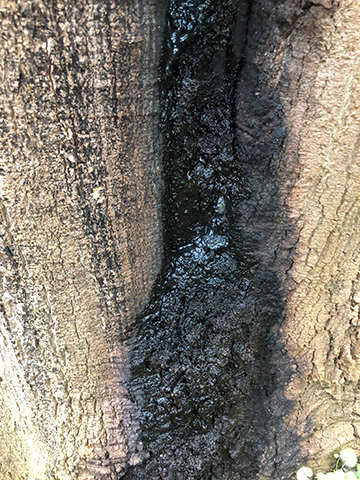Conserving Carolina seeking this month’s ‘Most Wanted Habitat,’ sap runs
Published 8:00 am Saturday, December 1, 2018

- Syrphid Fly (Sphiximorpha willistoni), a type of hoverfly that frequents sap runs. (Photo courtesy of Sam Houston)
In a joint effort to expand the knowledge and understanding of the flora and fauna of Polk County, Conserving Carolina and botanist David Campbell ask for the community’s help in locating this month’s “Polk County’s Most Wanted — Habitat,” sap runs.
Sap runs are a seldom noticed micro-habitat. They occur on trees where an injury has resulted from some type of physical damage such as a broken limb, lightning, disease, etc.
Sap runs are readily identified as dark streaks that occur on the surface bark of deciduous trees (in the local area, most commonly on oaks, tulip poplar, basswood, maple and beech, but by no means confined to these species).
Sap flowing from the tree wound (known as flux) contains sugar that provides food for bacteria and other types of microorganisms.
In turn, these microorganisms provide nourishment for the larvae of some variants of the hoverfly, which mimic stinging wasps and bees. The fly larvae feed on the microorganisms that are suspended in the liquid sap, in much the same manner as marine organisms that feed on plankton. The larvae of the hoverflies will “breathe” through tubes in their abdomens while submerged, just like a snorkel.
In addition to their beautiful appearance and behaviors, hoverflies are critical pollinators of countless native plant species, Conserving Carolina representatives said.
Other insects that frequent sap runs are butterflies, wasps and beetles, all integral to the proper functioning of the ecosystems.
Winter is a good time to look for sap runs on deciduous trees, as visibility is greatly enhanced by the lack of leaves. Trees with sap runs may be found anywhere, including backyards, but most commonly they occur on large, mature trees.
Those who think they have seen sap runs in Polk County can send photos, questions, comments and, where possible, the GPS coordinates of the trees, to Pam Torlina at Conserving Carolina by phone at 828-697-5777, ext. 300, or email at pam@conservingcarolina.org, so the agency can document its occurrence in Polk County. In the spring, (with the permission of landowners) staff may undertake visits to trees to survey the types and numbers of invertebrates present.
Those interested in learning more about “Polk County’s Most Wanted” can visit conservingcarolina.org/polk-most-wanted. Visitors can download and print a “Pocket Guide” with all of the “Most Wanted” plants, animals and habitats in the area.
– Submitted by David Campbell






